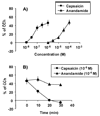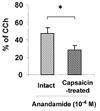The differential contractile responses to capsaicin and anandamide in muscle strips isolated from the rat urinary bladder
- PMID: 17586490
- PMCID: PMC2042539
- DOI: 10.1016/j.ejphar.2007.05.016
The differential contractile responses to capsaicin and anandamide in muscle strips isolated from the rat urinary bladder
Abstract
The contractile responses to capsaicin and anandamide, exogenous and endogenous agonists for transient receptor potential vanilloid receptor 1 (TRPV1), respectively, were investigated in muscle strips isolated from the rat urinary bladder. Capsaicin and anandamide produced concentration-dependent contractions of the muscle strips. The contractile response induced by capsaicin disappeared within approximately 20 min. In contrast, anandamide produced contractile responses lasting at least for 30 min. Capsaicin produced additive contractile responses in anandamide-treated muscle strips. The contractile response to anandamide was attenuated, but not abolished in strips desensitized by capsaicin. The response to capsaicin was abolished in the presence of a TRPV1 antagonist, N-(4-tertiarybutylphenyl)-4-(3-chlorphyridin-2-yl)tetrahydropyrazine-1(2H)-carbox-amide (BCTC), but not altered in the presence of either tetrodotoxin, atropine or indomethacin. In the presence of SR140333, a tachykinin NK(1) receptor antagonist or SR48968, an NK(2) receptor antagonist, the response to capsaicin was attenuated. The response to anandamide was partially attenuated in the presence of ONO8130, a prostanoid EP(1) receptor antagonist, URB597, a fatty-acid amide hydrolase inhibitor, BCTC, SR140333 or SR48968, and almost completely abolished by indomethacin. Neither tetrodotoxin, atropine, a cannabinoid CB(1) receptor antagonist, AM251, nor a cannabinoid CB(2) receptor antagonist, AM630, had any effect on the response to anandamide. These results indicate that capsaicin produces muscle contractions by stimulating the TRPV1 receptor, followed by release of neuropeptides that can activate tachykinin NK(1) and/or NK(2) receptors in the bladder and that the contractile response to anandamide is mediated at least in part by activation of prostanoid EP(1) receptors due to production of prostaglandins in addition to TRPV1 receptor activation.
Figures






Similar articles
-
The contractile effect of anandamide in the guinea-pig small intestine is mediated by prostanoids but not TRPV1 receptors or capsaicin-sensitive nerves.Basic Clin Pharmacol Toxicol. 2013 May;112(5):341-5. doi: 10.1111/bcpt.12041. Epub 2013 Jan 7. Basic Clin Pharmacol Toxicol. 2013. PMID: 23216932
-
Characterization of the vasorelaxant mechanisms of the endocannabinoid anandamide in rat aorta.Br J Pharmacol. 2007 Nov;152(5):699-708. doi: 10.1038/sj.bjp.0707404. Epub 2007 Aug 20. Br J Pharmacol. 2007. PMID: 17704831 Free PMC article.
-
Pharmacological characterization of receptor types mediating the dilator action of anandamide on blood vessels of the rat knee joint.Life Sci. 2007 Mar 27;80(16):1495-502. doi: 10.1016/j.lfs.2007.01.009. Epub 2007 Jan 18. Life Sci. 2007. PMID: 17275857
-
Why do cannabinoid receptors have more than one endogenous ligand?Philos Trans R Soc Lond B Biol Sci. 2012 Dec 5;367(1607):3216-28. doi: 10.1098/rstb.2011.0382. Philos Trans R Soc Lond B Biol Sci. 2012. PMID: 23108541 Free PMC article. Review.
-
Anandamide and the vanilloid receptor (TRPV1).Vitam Horm. 2009;81:389-419. doi: 10.1016/S0083-6729(09)81015-7. Vitam Horm. 2009. PMID: 19647120 Review.
Cited by
-
A new and automated method for objective analysis of detrusor rhythm during the filling phase.World J Urol. 2014 Feb;32(1):85-90. doi: 10.1007/s00345-013-1084-5. Epub 2013 Apr 30. World J Urol. 2014. PMID: 23633125
-
Potential therapeutic value of transient receptor potential channels in male urogenital system.Pflugers Arch. 2018 Nov;470(11):1583-1596. doi: 10.1007/s00424-018-2188-y. Epub 2018 Sep 7. Pflugers Arch. 2018. PMID: 30194638 Review.
-
TRPV1: on the road to pain relief.Curr Mol Pharmacol. 2008 Nov;1(3):255-69. doi: 10.2174/1874467210801030255. Curr Mol Pharmacol. 2008. PMID: 20021438 Free PMC article. Review.
-
Nitro-oleic acid targets transient receptor potential (TRP) channels in capsaicin sensitive afferent nerves of rat urinary bladder.Exp Neurol. 2011 Nov;232(1):90-9. doi: 10.1016/j.expneurol.2011.08.007. Epub 2011 Aug 16. Exp Neurol. 2011. PMID: 21867704 Free PMC article.
-
Endocannabinoids in Bladder Sensory Mechanisms in Health and Diseases.Front Pharmacol. 2021 Jul 5;12:708989. doi: 10.3389/fphar.2021.708989. eCollection 2021. Front Pharmacol. 2021. PMID: 34290614 Free PMC article. Review.
References
-
- Avelino A, Cruz F. TRPV1 (vanilloid receptor) in the urinary tract: expression, function and clinical applications. Naunyn-Schmiedebergs Arch. Pharmacol. 2006;373:287–299. - PubMed
-
- Birder LA, Nakamura Y, Kiss S, Nealen ML, Barrick S, Kanai AJ, Wang E, Ruiz G, De Groat WC, Apodaca G, Watkins S, Caterina MJ. Altered urinary bladder function in mice lacking the vanilloid receptor TRPV1. Nat. Neurosci. 2002;5:856–860. - PubMed
-
- Burstein SH, Rossetti RG, Yagen B, Zurier RB. Oxidative metabolism of anandamide. Prostaglandins Other Lipid Mediat. 2000;61:29–41. - PubMed
-
- Capasso R, Tavares IA. Effect of the flavonoid galangin on urinary bladder rat contractility in-vitro. J. Pharm. Pharmacol. 2002;54:1147–1150. - PubMed
MeSH terms
Substances
LinkOut - more resources
Full Text Sources

